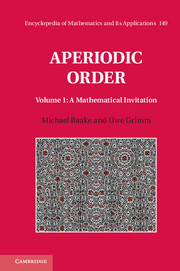
-
Select format
-
- Publisher:
- Cambridge University Press
- Publication date:
- 18 December 2014
- 22 August 2013
- ISBN:
- 9781139025256
- 9780521869911
- Dimensions:
- (234 x 156 mm)
- Weight & Pages:
- 1.08kg, 552 Pages
- Dimensions:
- Weight & Pages:
You may already have access via personal or institutional login
Book description
Quasicrystals are non-periodic solids that were discovered in 1982 by Dan Shechtman, Nobel Prize Laureate in Chemistry 2011. The underlying mathematics, known as the theory of aperiodic order, is the subject of this comprehensive multi-volume series. This first volume provides a graduate-level introduction to the many facets of this relatively new area of mathematics. Special attention is given to methods from algebra, discrete geometry and harmonic analysis, while the main focus is on topics motivated by physics and crystallography. In particular, the authors provide a systematic exposition of the mathematical theory of kinematic diffraction. Numerous illustrations and worked-out examples help the reader to bridge the gap between theory and application. The authors also point to more advanced topics to show how the theory interacts with other areas of pure and applied mathematics.
Reviews
'Mathematicians add hypotheses to theorems either to bar known monsters or provisionally to enable proof, pending better ideas that lead to more general results … Monsters no more, aperiodic filings have joined mainstream mathematics, and undergraduates drawn here by beautiful graphics will find themselves initiated into algebraic number theory, Lie theory, ergodic theory, dynamical systems, finite-state automata, Fourier analysis, and more.'
D. V. Feldman - University of New Hampshire
'Aperiodic Order is a comprehensive introduction to this relatively new and multidisciplinary field. Sparked by Dan Shechtman’s discovery of quasicrystals in 1982, which earned him the 2011 Nobel Prize in Chemistry, the field incorporates crystallography, discrete geometry, dynamical systems, harmonic analysis, mathematical diffraction theory, and more. Because the field spans such disparate fields, advances by one group often go unnoticed by the other. An important goal of this book is to remedy this by unifying and contextualizing results and providing a common language for researchers. … Readers who want to follow up on any details can certainly find a reference in the nearly 30 pages of bibliographic entries. Full of examples, construction techniques, and an array of analytic tools, this book is an outstanding resource for those hoping to enter the field, yet also contains plenty of useful information for seasoned experts.'
Natalie Priebe Frank Source: Mathematical Association of America
Contents
Metrics
Altmetric attention score
Full text views
Full text views help Loading metrics...
Loading metrics...
* Views captured on Cambridge Core between #date#. This data will be updated every 24 hours.
Usage data cannot currently be displayed.
Accessibility standard: Unknown
Why this information is here
This section outlines the accessibility features of this content - including support for screen readers, full keyboard navigation and high-contrast display options. This may not be relevant for you.
Accessibility Information
Accessibility compliance for the PDF of this book is currently unknown and may be updated in the future.


